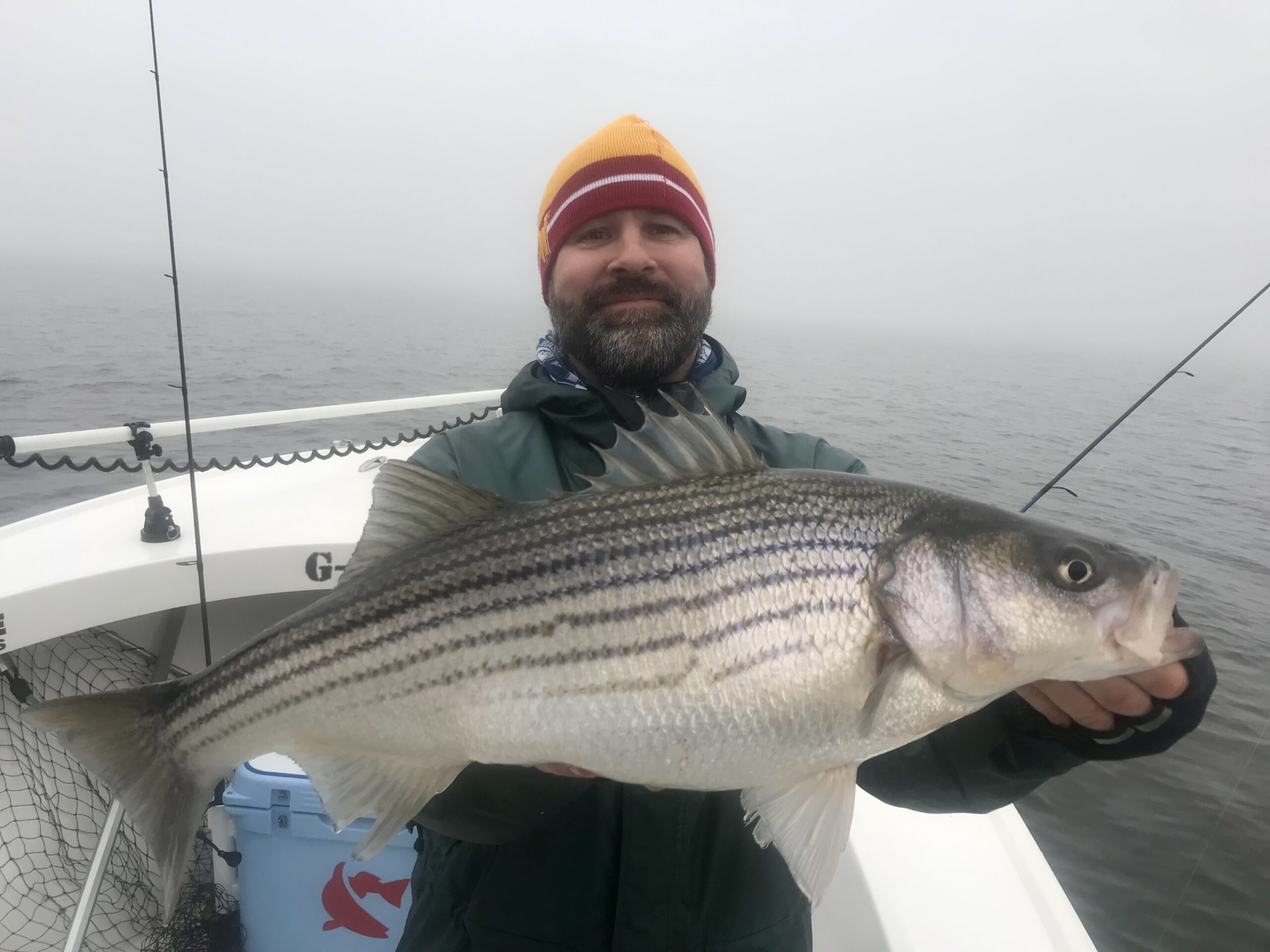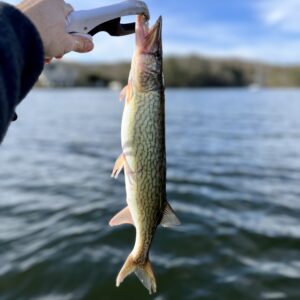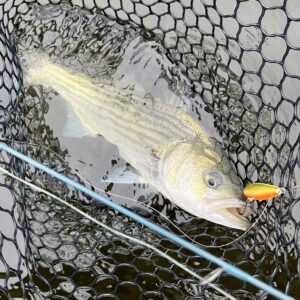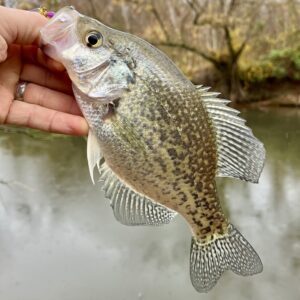Diehard anglers forever crave the next cast, be it the first or last of the day. Or, in this case, the year-end finale! For the second straight New Year’s Eve, I was on the water casting into oblivion for prized fish. Our Chesapeake Decembers have generally been mild the last few seasons and even with January knocking on the door, conditions would be somewhat favorable for fishing. On 12/31 last year, I spent the entire day on the Severn River and completed a slam, catching yellow perch, pickerel, and even a surprise striped bass. So, what did the last casts of 2022 have in store? A completely different experience!
Just after Thanksgiving, I received an invite from fellow Severn angler Eddie Weber to join him on a trip out of Point Lookout State Park, Maryland, to hunt for big striped bass. We’d be captained by Travis Long of Schooled Up Fishing Charters and joined by several more anglers, including Weber’s longtime friend and Annapolis-area angler Chase Sutton. My only hesitation going in was whether this trip would be rote trolling or technical jigging—the latter being preferred for its challenge, skill required, and action that puts the pressure on the angler as much as the equipment. To my relief, Weber let me know this trip would be “jigging only, and from a 24′ Judge!” Sign me up.
In the wee, pre-dawn hours the morning of, we made the two-hour drive south from Annapolis to the state park’s boat ramp, where Long met us just before sunrise to launch his vessel. Point Lookout’s proximity to more southern Chesapeake Bay waters gave us a better shot at the larger resident striped bass that, for the past two months, have been chasing bait (menhaden/bunker) spilling out of the northern and mid-Bay rivers that migrate south to the Atlantic Ocean. In this portion of the bay, there’s also the confluence of anadromous striped bass migrating down the Atlantic coastline and back into the lower Chesapeake Bay to overwinter and bulk up in preperation for their spring spawn. So, the chance to hook into a trophy striper is very real on the last day of the year!

Eerily, a dense fog hung on the bay as we began motoring from the ramp into deeper water—25 yards visibility tops. The hope was that it would burn off as the sun inched higher. But it never lifted. I don’t even recall seeing the sun the entire day. So we’d be driving blind, so to speak. Long relied exclusively on his electronics to navigate what felt like an abyss, toward the waypoints where we’d drift and jig. The good news? Overcast days like this should be ideal for a long-lasting bite. Doubly so on this unseasonably warmer day with air temps peaking at 45–50F. Altogether, the conditions felt odd, but offered a good dose of hope.
We had five anglers aboard and that gave us an advantage over the fish. How? We could present five different options/lures to the fish, which allowed us to key in on their preference of the day. The setups all anglers employed were 6’6″–7′ medium spinning rods paired to either 2500- or 3000-class reels spooled with 15# braid mainline and three-foot 20# flourocarbon leaders—a typical Chesapeake jigging outfit. A couple anglers (myself included) began the day jigging heavy metal—2oz spoons. Others tried jigheads (about 1 to 1.5oz) tipped with 5–7″ plastic shad bodies or paddletails. Our colors ranged from chartreuse to silver, with white, blue, and, even, pink mixed in. A solid range of presentations overall. Standard fare honestly.

We tried several of Long’s waypoints that put us in water 20 to 70′ deep, generally atop and adjacent to dropoffs on either side of the shipping channel that runs along the middle stem of the bay. West side, then east. We seemed to run back and forth several times in search of wolfpacks of fish that would hopefully lead to larger schools. With our eyes attentive to the sonar, we were looking for long arches clustered together indicating fish below. A few times we found them, but no hookups. In the hours before noon, we had nothing to show but proof our foul weather gear was working. Nonetheless we persisted. I said to Weber at one point, “Gotta keep grinding.” He nodded. We know the grind is what we sign up for when fishing in mid-winter.
Then, it happened. A hookup with a healthy 30″ striped bass while on a settled drift that began in 20′ of water on the eastern shore side of the shipping channel, moving across a drop into 50-and-change-foot depths. Suddenly the mood on the boat changed and everyone’s eagerness to connect ramped up. By this point, I had switched to a 1.5oz white/chartruese jighead tipped with a 5″ Zman DieZel MinnowZ in “hot chartruese.” Despite the sonar not showing much life on screen, I dropped the jighead to the floor and gently began bouncing it, feeling the lure thump along between light twitches/jigs upward. This was altogether different than the more aggressive snap-jigging technique that works well to temp fish suspended higher in the water column. It didn’t take long before I felt a striper suck in the lure, set the hook, bent the rod, and played fish No. 2 on the day over the boat’s gunnel. A nice 27″ or so fish. We might be on to something afterall.

Long circled the boat for a second drift over this spot. Sutton connected. His lure was similar to mine, but in white and blue colors—another good mimic of the menhaden that these fish had been feeding on. Weber quickly changed gears, switching out the large spoon he had been dropping in favor of a jig/paddletail combo. Long searched his plastics box for more DieZel MinnowZ in a blue pattern, pulling out a bag of ’em in “disco cisco” color—a hynotic mix of blue/silver/turquoise shades. Weber threaded it on and in short order had his first catch of the day. Jigs ‘n’ paddletails—hot damn, we had the stripers’ preferred lure.

Occassionally on our repeated drifts, the sonar would light up with condensed arches top to bottom. But interestingly, many of our fish hit while jigging against a blank canvas. Perhaps the fish were so tight to the bottom, the sonar barely indicated their presence. Regardless, with consistent action and each angler aboard connecting, we felt good enough about this drift, pattern, and technique to stay put for the remainder of the day. By 3:30 p.m., however, the bite seemed to cool off, the weather began picking up (rain incoming), and we felt satisfied with the day’s catch. We boated roughly 30 solid stripers, most in the 20–25″ class, but very, very heavy with bulging bellies full of baitfish. All fish caught and released per Maryland regulations.
Just before packing it up for the final run across the Chesapeake Bay back to Point Lookout’s boat ramp, Sutton was hopeful for one last fish, himself having hit a slight stall in the action earlier. And on our last casts of the day, he played the lure, felt a heavy “thwop!,” and pulled up a chunk that finished the outing in style. A healthy striped bass good for those “last cast smiles” and hopes that the end to 2022 bodes very well for an amazing 2023. Happy New Year and see y’all on the water again, real soon!





